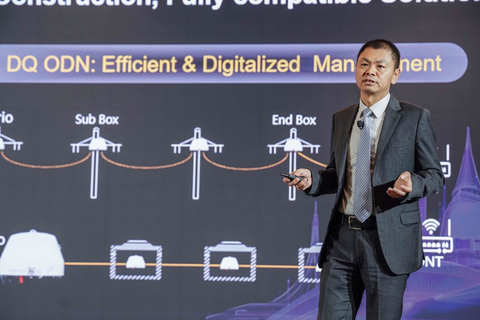At the Green All-Optical Network Summit of the 8th Ultra-Broadband Forum (UBBF 2022), Kim Jin, Vice President of Huawei Optical Product Line, delivered a keynote speech entitled “F5.5G-Oriented Innovations Drive Growth”. In the speech, Kim Jin explained the opportunities and challenges in the optical communication field during global digital transformation. He also proposed Huawei’s key innovative solutions to help operators achieve business success in the home and enterprise markets during the evolution to F5.5G. Furthermore, he called on the entire industry to seize the opportunities of the digital era, start deploying innovative solutions, and embrace new growth in the communications industry.
As the development of the traditional telecom industry slows down, new growth points are required. However, the potential of the global home broadband industry has not been fully unleashed, especially in terms of home broadband coverage and home network experience. In addition, the digital transformation of industries will open up greater space for telecom market growth. Premium home and enterprise services are expected to grow by more than 10% every year for the next few years. Against this backdrop, getting network capabilities ready in advance will be a key factor for operators to seize the next wave of digitalisation opportunities. With this in mind, Huawei has developed the innovative CO+X network construction solution, FTTR for home solution, all-optical super site solution, OptiX Alps-WDM solution, and 400G OXC 3D-mesh backbone network solution to help operators achieve business success in the future.
CO+X network construction solution: accelerating fixed broadband deployment
To help operators tap into fixed broadband services to provide more homes with faster speeds at lower costs, Huawei has developed an innovative CO+X network construction solution. In this solution, a wide series of branch OLTs are extended from OLTs in the CO equipment room. These branch OLTs can be deployed in street cabinets or mounted on walls or poles and can be managed in an integrated manner. This solution helps operators quickly cover more areas using fewer CO equipment room resources, effectively accelerating FTTH network construction and reducing the overall construction cost by 23%. In addition, Huawei has launched the DQ-ODN solution that uses the pre-connection mode to replace the inefficient traditional network construction mode that relies on fiber splicing. The DQ-ODN solution improves the construction efficiency by 30% and greatly reduces operators’ ODN construction costs.
FTTR for home solution: redefining home broadband experiences
With intensified competition in the home broadband market, providing differentiated quality experiences will be the key to improving operators’ competitiveness. Huawei has launched the innovative FTTR for home solution that extends gigabit networks to rooms using optical fiber connections. Specifically, this solution uses ultra-flexible transparent optical fibers to extend to each room in a home, providing high-speed Wi-Fi coverage in each room. Through centralised control and orchestration of Wi-Fi signals, this solution reduces interference, improves the roaming handover speed, and achieves seamless gigabit broadband experiences in all corners of a home.
All-optical super site solution: improving connection quality
To better serve enterprises, Huawei has developed the unique OLT+OTN co-site deployment solution. With this solution, Huawei builds on the ODN optical access network to provide four types of networking schemes to connect large enterprises, small and medium-sized enterprises, micro and small enterprises, and homes, respectively. Operators can select a specific connection quality according to the service requirements in a particular scenario, reducing the TCO by about 50%. On the basis of all-scenario coverage, the OSU private line solution can also implement fast enterprise private line connections in end-to-end mode, support on-demand bandwidth adjustment from 2 Mbps to 100 Gbps and provide flexible and premium private line services for various enterprises.
OptiX Alps-WDM solution: making networks more flexible
Huawei has also released the OptiX Alps-WDM solution to address the uneven bandwidth requirements of metro networks, as well as the requirements for more flexible wavelength resource grooming. This solution uses the innovative wavelength resource pool technology. With this technology, fewer components are required on each metro aggregation node, and wavelength resources can be shared and flexibly groomed between the connected access rings. In this way, transmission resources can be flexibly allocated, reducing network maintenance costs by more than 20%. This solution also supports smooth evolution from 100G to 400G.
400G OXC 3D-mesh backbone network solution: building ultra-broadband backbone networks
With the advent of the digital wave in various industries, networks will face a 10-fold increase in both connection quantity and traffic volume. Operators’ networks must have powerful capabilities built in advance to embrace new opportunities brought by industry digitalisation. To address this challenge, Huawei has launched the 400G 3D-mesh backbone network solution with ultra-wide optical spectrum to improve the spectral efficiency of optical fibers by 50% and reduce the per-bit cost by 30%. This solution helps operators build ultra-high-bandwidth and highly reliable backbone networks.
At HUAWEI CONNECT held in September this year, Huawei released “Striding Towards the Intelligent World” series of white papers, including the F5.5G all-optical network white paper. This white paper points out the future development directions and technology trends of F5.5G networks. Huawei’s key innovative solutions will further promote the F5.5 evolution of the industry. Kim Jin said: “Huawei is willing to work with customers and partners to stride to F5.5G, and build ubiquitous optical connectivity and OTN sites, helping the industry embrace new growth.”
From October 27 to 28 this year, the 8th Ultra-Broadband Forum (UBBF) co-hosted by the UN Broadband Commission and Huawei was held in Bangkok, Thailand. This forum brought together global leading operators, industry leaders, regulators, standards organisations, industry alliances, and more, and focused on the theme of “Stride to Ultra-Broadband 5.5G”. It thoroughly analysed the business opportunities that ultra-broadband networks bring to the digital development of homes and industries and explores the evolution and innovation development directions of the fixed network industry for the next 5 to 10 years.










Discussion about this post